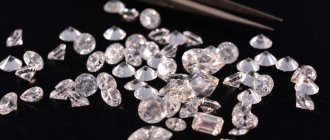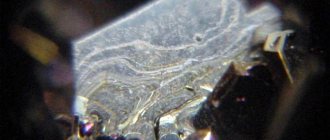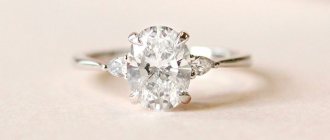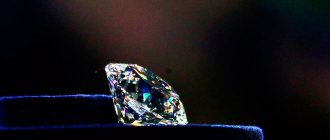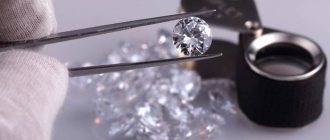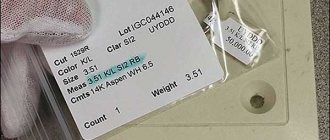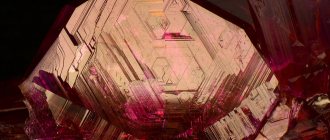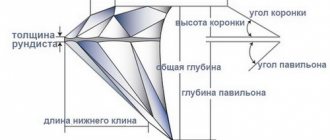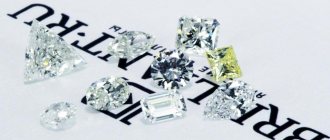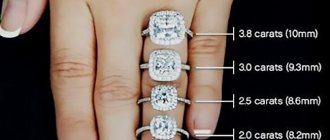Origin story
The stone is named after its discoverer, Henri Moissan. He explored the area of the meteorite fall in the US state of Arizona in 1893. In the cosmic body, the scientist found plates of moissanite, previously unknown in mineralogy.
Interestingly, long before the discovery in the 20s of the 19th century, a similar chemical material was obtained by Jacob Berzelius . The scientist proposed using the durable mineral for technical purposes for spraying tools and grinding stones. But the invention was underestimated and not recognized.
Later, the stone began to be found in other fragments of meteorites, but they could not be processed. The small number of specimens did not allow finding a field of application for the new mineral.
But soon silicon carbide powder (the chemical basis of moissanite) was created in the laboratory by Edward Acheson . He owns a patent for an artificial analogue of moissanite - carborundum, and for a special furnace for its processing, which is still used today.
Nowadays, stones for jewelry - moissanite - are made from powdered silicon carbide.
Cosmic moissanite, or the younger brother of the diamond
As you already understand, today I want to talk about an unusual stone called moissanite. I heard about this crystal with a diamond shine, but until yesterday I had not held products with moissanite in my hands, since in Russia this stone is little known and not widespread in jewelry stores. I can’t describe my feelings, there really is something alluring about this stone. The most interesting thing is that the moissanite in my ring has the most common cut, but despite this, it is very difficult to take your eyes off the product. And, as you know, it is the cut that makes the stone shine and shimmer, giving it a beautiful shine. I can’t even imagine how shiny moissanite would be, for example, with a trillion cut. One thing I can say for sure is that I was so fascinated by this stone and its brilliance that I re-read dozens of pages about moissanite and now I want to share my knowledge with all the readers of the Masters Fair.
The photo shows moissanite in four colors; the photo in the center and on the right is an example of jewelry.
Moissanite is a rare silicon carbide mineral with the formula SiC that forms small crystals with a diamond luster and is colorless, green, yellow and black.
Silicon carbide.
Silicon carbide was first described by Jacob Berzelius in 1824. And in 1905, scientist Henri Moissan found tiny shining crystals of silicon carbide in a meteorite that fell in Arizona, forming a huge hole on the surface of the earth about 175 meters deep and almost one and a half kilometers wide. Later, the mineral was named after the scientist - moissanite.
Arizona Crater (Canyon Diablo Crater).
So, moissanite is very rare on Earth, it can be found in some types of meteorites or in deposits of corundum (a type of mineral) and kimberlites (a rock where diamond is sometimes found). But in space, silicon carbide is widespread in dust clouds around carbon-rich stars and, of course, in meteorites.
Moissanite appeared on the Russian jewelry market only in 1995 and is quite rarely found in store windows, which explains the ignorance of many Russians about the existence of this enchanting crystal. In terms of its hardness, it is second only to diamond, surpassing ruby, emerald and blue sapphire, which means that the stone will not appear scratches, chips or signs of abrasion. A diamond detector identifies moissanite as a diamond, so it is possible to distinguish a diamond from moissanite only with the help of gemological examination. But none of the precious or semi-precious stones can compare with the radiance and brilliance of moissanite, which shimmers with all the colors of light, exceeding even the wildest expectations. The most interesting thing is that moissanite shines more than a diamond (the refractive index of moissanite is from 2.65 to 2.69, while a diamond has only 2.42), and does not fade or tarnish over time from wear. And with a dispersion 2.4 times greater than that of a diamond, moissanite transforms light rays into mesmerizing rainbow flashes of fire. This crystal plays with all the colors of the rainbow, regardless of the time of day, and creates the effect of reflection and refraction of light even in candlelight.
Moissanite, diamond cut.
This crystal is only 10% lighter than a diamond of the same size. The 6.5mm moissanite is exactly the right size for setting a 1 carat diamond, but weighs 0.88 carats. If you are purchasing moissanite by weight, you will need to purchase a stone that is 10% heavier than the diamond weight.
Finally, I would like to say that if you are planning to purchase diamond jewelry, consider moissanite. It is much cheaper than diamonds, but sparkles brighter. It is also of high quality and is an excellent gemstone. Of course, this is not a diamond, and if you want to buy a diamond, buy it. But moissanite is an excellent alternative.
Thank you for your interest in the article!
Best regards, silver_avenue.
Moissanite and cubic zirconia
Real moissanite is a very durable stone with a diamond or metallic luster . For example, its hardness on the Mohs scale is 9.25.
For comparison: a diamond has 10. In a meteorite, the mineral does not exceed 3 mm in size, and is capable of melting only at 2800 °C. This description allows you to compare moissanite with a diamond and its imitations, such as cubic zirconia.
What is cubic zirconia
Cubic zirconia is an artificial stone not found in nature. It consists of zirconium oxide and non-ferrous metal oxides, which color the mineral in various shades. Colorless cubic zirconia imitates a diamond, and colored cubic zirconia imitates other precious stones .
Cubic zirconia is quite hard (8 on the Mohs scale) and heavy (density 10 g/cm3). The cost of cubic zirconia is very low compared to natural minerals, which explains its widespread use in jewelry.
Carborundum and cubic zirconia
Although both stones are created to imitate a diamond and are of synthetic origin, their properties differ significantly :
- Cubic zirconia is easier to scratch, but only diamond can damage moissanite.
- The refractive index of carborundum is higher, which means that more rays are reflected from it and creates “diamond” shimmer. Cubic zirconia crystals transmit most of the light through themselves.
- High strength makes it possible to make the edges of carborundum clear, while in cubic zirconia they initially or over time become rounded. Scratches, chips or cracks may appear on cubic zirconia jewelry while worn.
How to distinguish
It is not difficult to distinguish cubic zirconia in jewelry with the naked eye : its shine will be much less than that of moissanite. The beveled edges of cubic zirconia can be examined under a magnifying glass.
Jewelers can easily distinguish these stones by their thermal conductivity using a diamond tester. It defines carborundum as a diamond.
View this post on Instagram
Posted by JEWELERY WORKSHOP (@polarstr) Oct 8, 2021 at 11:48 am PDT
An artificial diamond - moissanite - will not retain traces when touched with fingers. When heated under a candle flame, carborundum begins to emit a green spectrum of light. Under an ultraviolet lamp, red and orange rays predominate .
Advice! In a specialized store, before purchasing, at the client’s request, they can show a certificate with the name of the stone, its cutting method, weight and manufacturer.
What is moissanite
This is the name of a synthetic mineral obtained in laboratory conditions. Essentially, this is a crystal grown from silicon carbide. It has the same properties and appearance as diamond material, but still differs in some characteristics. It is impossible to distinguish it from a real pebble with the naked eye, so the use of specialized equipment is necessary.
This material was first submitted to gemologists for consideration in 1996 in the city of Tucson. He immediately attracted the attention of many scientists and they began to study him closely.
It is interesting that not all methods popular at that time made it possible to identify a fake. For example, by measuring the thermal conductivity of a mineral, it was possible to easily distinguish diamond from its analogue, strontium titanate, cubic zirconia, or synthetic sapphire. But with moissanite, everything is much more complicated: thermal conductivity tests did not give results - they identify it as a diamond. That is why alternative methods of determining the authenticity of stones were required.
Carborundum – artificial moissanite
Carborundum has become practically the only way to use the properties of moissanite for making jewelry. A natural mineral is too rare a find , which is practically impossible to process due to its small size and lamellar structure.
The invention of carborundum made it possible to produce large stones similar to diamonds in external and physical properties.
For the first time, the American campaign CREE attempted to create an analogue of a diamond from artificial moissanite. In 1987, large samples of moissanite were created on an industrial scale. Since 1995, diamond cutting has been tried on them, and the reviews from jewelers were enthusiastic.
Magic properties
Talismans with moissanite attract good luck and help reveal the best character traits, while amulets and amulets protect against adversity. Any jewelry with natural/artificial stone has the same magical properties.
The stone itself helps to keep emotions under control, gives courage and strengthens the spirit, and supports in difficult life situations. It helps to overcome fear and self-doubt, develops the talent of eloquence, and does not allow any factors to influence the decisions of its owner. The stone can also improve your financial situation.
Interacting with all chakras, it purifies energy flows and human spirituality.
Reference! Both the stone itself and any products with it are suitable for magical effects. Natural moissanite does not need to be activated, but the synthesized mineral needs to be charged.
To do this, during the period when day and night last the same amount of time, the artificial stone must be left in direct sunlight. It is best to carry out the recharging procedure in the fresh air and in the morning, during dawn. The charging time of the stone is equal to the entire period until the sun rises.
Moissanite in jewelry
The popularity of moissanite (carborundum) in the jewelry industry is understandable: in some characteristics the stone is even superior to a diamond .
The only drawback that does not allow replacing the precious mineral completely is its artificial origin.
View this post on Instagram
Publication from CUSTOM JEWELRY (@uvelir_moskva) Sep 30, 2019 at 1:15 PDT
Knowing how to distinguish moissanite from a diamond, you will not fall for the tricks of unscrupulous jewelers:
- Moissanite shimmers in the light with darker highlights than a diamond.
- The refractive index of carborundum is higher than that of a precious stone, and it reflects rays 20% more and shimmers.
- Moissanite does not fade when touched by fingers, unlike diamonds.
- Under a magnifying glass, the polishing lines of the edges are visible: in moissanite they are parallel to each other, while in precious stone they are in different directions. The edges of the edges of the artificial stone bifurcate from the inside.
- Finally, each gemstone has a certificate of quality with its name and main characteristics.
What does the cost depend on?
The price of a product with moissanite depends on the same indicators as other minerals:
- weight;
- color;
- processing method;
- cost of precious metal;
- production and delivery costs.
Moreover, the last point plays an important role - expensive equipment is used during production and a lot of electricity is spent . In terms of cost, moissanite is comparable to a high-quality artificial diamond.
View this post on Instagram
Posted by Moissanite Manufacturer-Vivian (@moissanite_factory) Oct 1, 2021 at 9:48 am PDT
What goes with it?
Moissanite can be combined with any precious metal. Moissanite is neutral in relation to other stones and can be used to realize any design ideas.
The main thing, like a diamond, is not to combine it with ornamental stones.
What jewelry does he look best in?
Jewelry with moissanite reveals its beauty to the fullest in jewelry:
- long earrings or studs;
- engagement or wedding rings;
- pendant on a short gold chain.
View this post on Instagram
Posted by Moissanite/Products/Jewelry (@moissanite_paradise) Mar 7, 2021 at 12:50 PST
It is appropriate to wear jewelry for the bride , for special events, dinner in a restaurant. Men can also wear jewelry with moissanite in the form of a ring or cufflinks.
How to distinguish moissanite from diamond
The differences between diamond and moissanite are so insignificant that it is not possible to determine them with the naked eye at home. This is only available to a qualified gemologist with special equipment.
In order to distinguish a diamond from synthetic moissanite, several methods are used:
- Optical test - using a microscope, the cleavage of minerals is studied. In diamond, the cleavage of the crystals is quite sharp, while in artificial stone it is smoother. Such a difference cannot be determined without special optics.
- Comparison of the specific gravity of two samples - it is higher for a diamond than for an artificial gem. Therefore, in a special chemical solution, a diamond will sink, unlike its synthetic counterpart.
- Ultraviolet luminescence test - it is not applicable to very small samples, such as natural moissanite. When artificial stone is irradiated, it completely absorbs the light of ultraviolet rays. But this method cannot claim absolute accuracy, since some diamonds have increased fluorescence and therefore behave like synthetic minerals in this situation.
- Determination of electrical conductivity - this method allows you to distinguish natural minerals from artificial ones using special instruments. They can accurately identify counterfeit gemstones.
Moissanite price per 1 carat
The price of 1 carat of cut stone without color reaches $300. Green copies are 30% cheaper, and yellow and brown ones are almost 2 times less. It is not economically feasible to produce small moissanite stones up to 2 mm: they cost almost the same as natural diamonds.
The cost of jewelry with colorless moissanite weighing 0.1 carats starts from 10 thousand rubles. (ring or earrings) .
Which is better, moissanite or diamond? Of course, everyone has their own choice, depending on individual preferences. Now among all the precious stones there is a stone that can outshine any precious stone with its sparkle - this is moissanite.
Moissanites differ little from diamonds
There are several facts that may surprise anyone interested in whether moissanite or diamond is better. Even many jewelers consider moissanite to be a premium gemstone. And why?
- Moissanite is as colorless as diamond. Diamond clarity is graded precisely by color, an important property for these stones.
- Moissanite has a hardness of 9.25 on the Mohs mineralogical scale. A diamond on the same scale has a 10. Moissanite is the second hardest mineral on our planet.
- Moissanite has a high dispersion (the ability to scatter light) - 0.104. The diamond has a dispersion of 0.044.
- Moissanite also has a greater ability to refract light, that is, create more shine - 2.65. For a diamond, this light refractive power is rated at 2.42.
- Moissanite is a human-grown stone; in natural conditions it was found only in meteorites. The diamonds from which diamonds are made are mined on our planet, but today there are companies that grow artificial diamonds.
- Moissanite is ten times cheaper than a diamond. Companies selling diamonds present us with diamonds as a profitable investment; the average buyer hardly thinks about making money on stones. And if you sell a diamond, then initially they will offer a price lower than its original market price.
- The production of moissanite, the patent belongs to one.
- Both of these minerals, moissanite and diamond, have been hand-cut before bringing out their best qualities.
Moissanite is graded based on 4 main parameters - cut, clarity, color and carat weight.
Moissanite color
Moissanite does not have the color of FGHI diamonds, but a slight yellowish or greenish tint can appear in moissanite under certain lighting conditions. The circle cut is usually the lightest and most popular cut. Pear-shaped moissanites exhibit a green or yellow tint and are more similar to IJK diamonds. The larger the moissanite, the greater the color. When purchasing jewelry through an online jewelry store, most often there is no opportunity to see the product before purchasing, so you need to make sure that the company's policy allows the consumer to return the stone if it is a different color than desired. For those who enjoy the sparkle of warm-toned diamonds, moissanite is the perfect choice. The bright shine of moissanite perfectly masks excess color.
Purity of moissanite
Moissanite looks like a perfectly clean stone, but with high magnification you can see inclusions from the creation of the stone.
Moissanite carat
Moissanites are often measured in mm. For example, 6.5 mm of round moissanite equals 1 carat of diamond.
Moissanite cut
Moissanite will not have the same beauty if it is cut in exactly the same proportions as a diamond. This is determined by the different optical properties of the stone.
Moissanite forms
Nowadays you can buy moissanites in the same shapes as diamonds, but round moissanites are in great demand.
Comparison of prices for moissanites and diamonds
Moissanite is more expensive than cubic zirconia, diamondite and many other synthetically grown stones. Moissanite is a stone processed by human hands that retains its beauty for as long as a diamond. After some time, cubic zirconia will become cloudy and its edges will be erased, which means that the original shine will disappear. The production of moissanites takes a rather long process, which requires stable and powerful electrical substations. therefore, quite a lot of electricity is consumed, the costs of producing moissonites are not small, since it is a long process and costly in terms of electricity and time.
Below are the dollar prices for the properties listed above.
Here are the parameters for evaluating properties: color FI, clarity VS1-VS2, ideal cut, carat, circle cut shape. Diamond prices depend on the color of the stone: the lighter the stone, the more expensive it is.
0.5 carat - perfect cut, I - color, VS1: $1213
0.5 carat - equal moissanite: $95
Price difference: $1118
0.75 carat - perfect cut, I Color, VS2: $2776
0.75 carat - equal moissanite: $200
Price difference: $2576
1 carat - perfect cut, I Color, VS2: $6210
1 carat - equal moissanite: $275
Price difference: $5935
1.5ct - Perfect Cut, I Color, VS2: $11,996
1.5 carats - equal moissanite: $460
Price difference: $11536
2ct - Perfect Cut, I Color, VS2: $19,272
2 carats - equal moissanite: $610
Price difference: $18662
3 carats - perfect cut, I Color, VS2: $45,252
3 carats - equal moissanite: $839
Price difference: $44413
4ct - Perfect Cut, I Color, VS2: $64811
4 carat equivalent moissanite: $1125
Price difference: $63686
You can save a lot of money by purchasing a ring with a moissanite ring rather than a ring with a diamond of the same diameter.
It is impossible to distinguish a moissanite from a diamond with the naked eye; even most jewelers who do not have the necessary equipment to evaluate a moissanite will most likely confirm that it is a diamond before their eyes. Even some diamond testers rate moissanite as a diamond. It’s up to you to decide what exactly to buy: diamonds or moissanites that are better in brilliance and an order of magnitude lower in price.
The healing properties of moissanite
Despite the synthetic origin of carborundum, lithotherapists endow it with healing properties. Moreover, not only contact with the stone, but also its frequent contemplation can have an effect. The positive effect occurs at the subconscious level due to improved transmission of nerve impulses in certain parts of the brain.
Recommended for:
The stone can be recommended for people suffering from memory impairment, nervous system lability, and loss of vitality.
Important! The stone is unable to cure serious somatic diseases without traditional treatment.
What ailments does it relieve?
By improving the activity of the areas of the brain responsible for the perception of pain, you can get rid of migraines and chronic spasms of the digestive system .
Moissanite will help get rid of the effects of severe stress, depression and other mental disorders.
Interestingly, black moissanite is considered a universal healer : it has a positive effect on the entire body.
What are the differences from diamond?
Even though it resembles a diamond, moissanite is actually very different in quite a few ways. Here are some of the most significant differences between them:
Hardness.
Like a diamond, moissanite is very hard. Its hardness is 9.5 on the Mohs hardness scale, while a diamond has a hardness of 10.
The durability of moissanite is one of the reasons why it is likened to diamond.
Moissanite has more shine.
Moissanite is brighter and more brilliant than a diamond of similar clarity, color and cut. In addition, it has the so-called “double refraction”.
This means that if you look through the top or side of a polished round moissanite, the facets on the opposite side of the stone will appear doubled in size. This effect cannot be seen in diamonds.
Moissanite has more "fire".
The so-called "fire" effect is another name for dispersion, which refers to the way the stone breaks up light into spectral colors.
When light enters moissanite, the fire produced is more intense.
So, if you hold a moissanite in front of your eyes against a light source, the flashes you see should be larger and more colorful than what you would see in a diamond.
Color.
Here, diamond is the clear winner. Considering that the highest quality diamonds are colorless, there are no moissanites that can meet this standard.
All moissanite available is colored in some way, no matter how little.
The best color of moissanite you will be able to find is white with visible yellow tints, but not the pure white found in top quality diamonds.
Moissanite has a lower density and specific gravity compared to pure diamond. This means that if you compare the weight of a moissanite and a diamond of the same size, the former will be lighter.
Moissanite is cheaper.
Moissanite costs a fraction of the price of a real diamond. For example, moissanite can sell for 10-15% of the price of a diamond of similar clarity, color, cut and size.
While a low price tag may indicate that the stone is not a diamond, don't assume you're being offered the real thing just because it's expensive—there are sellers who would be happy to offer you a fake stone for the price of the real thing.
This is one of the main reasons that moissanite may be preferable - it is much cheaper, and can cost around one-tenth the price of a comparable diamond.
Moissanite has a higher purity.
Most moissanite sold these days is created in a laboratory under controlled conditions that minimize internal defects, which is why this stone tends to have a higher clarity than most diamonds.
While the presence of a few inclusions doesn't necessarily mean the stone is moissanite if its price is unusually low, it can at least be a signal that you're not looking at a real diamond.
Magical effect on human destiny
A synthetic stone can only exert magical effects after being recharged.
Does hydrothermal moissanite work?
Newly purchased moissanite is charged with fiery energy from the sun. The stone should be taken outside or placed near an open window under the rays of the rising sun.
You can clean in the afternoon, when the sun begins to descend from its zenith.
What areas of life does it improve?
Moissanite or carborundum will help you develop your best qualities and attract financial wealth. The crystal interacts with human chakras and brings harmony of energy to each of them. With constant interaction with the stone, the financial sphere of life and relationships with others will improve due to changes in the emotional background. Moissanite increases self-esteem, confidence in the success of new endeavors and helps in the fight against fears.
View this post on Instagram
Posted by Moissanite Manufacturer-Vivian (@moissanite_factory) Oct 1, 2021 at 9:31 am PDT
Who is moissanite suitable for?
You can try to correct the following qualities with the help of moissanite:
- desire to do everything perfectly (perfectionism);
- excessive control over the lives of others;
- excessive emotionality and sensitivity.
The mineral is suitable for people in public professions who need a feeling of self-confidence and improved speaking abilities.
Stone according to zodiac sign
Astrologers classify the stone as a fire element. Therefore, he will best help Aries and Leo . For air signs of the zodiac, the stone will help improve their emotional state. Pisces, Virgos, Capricorns, and Taurus can wear moissanite as a protective amulet .
Methods for determining moissanite
How to distinguish moissanite from a diamond? Here are some proven methods:
- Optical method. Using optical instruments (microscope), the cleavage of the sample is determined. Typically, diamond minerals have fairly sharp cleavage on their faces, while synthetic materials have smoother edges. Also, in the light, the moissanite mineral glows in different colors, while the diamond sample is more monotonous. With the optical method, differences are noticeable, but you cannot do without special optics.
- Specific gravity. The two samples have different specific gravity. For a real stone it is 3.52, and for a fake it is approximately 3.2. Of course, just by holding it in your hand you cannot distinguish the specific gravity of one crystal from another, but this can be done by using some chemical liquids. By placing a gem in a certain liquid, you can see whether it floats or not. A diamond will sink in the same substance, while a synthetic stone will float. However, it is worth noting that the specific gravity of cubic zirconia is the same as that of a processed diamond, so it is most likely impossible to distinguish them by lowering them into liquid - the result will be the same.
- Sample hardness. As you know, diamond is the hardest precious mineral and can even be used to cut metal. On the Mohs scale, it has a rating of ten, so it is capable of deforming other minerals with a certain force. If you run a sharp corner of a real stone across moissanite, small scratches should appear on its surface. If there are no scratches, then this pebble is not fake. The disadvantage of this method is the possible damage to the sample, and the synthetic pebble also costs money.
- Heat treatment. When exposed to fire, fake jewelry can change its color. This is due to the presence of various inclusions. So, if you bring an ordinary match or lighter to a synthetic pebble, it will begin to glow green. With prolonged exposure to fire, a greenish coating may form on the surface of the gem. It is worth noting that the plaque will be very difficult to remove later, so we do not recommend experimenting with fire for a long time.
- Refractive index of light. Gemologists have developed devices to determine the refractive index of light, which allow them to distinguish real jewelry from a fake. However, scientists are faced with the problem of bypassing this method. Some manufacturers apply a special substance to moissanite (like on sunglasses), which changes the refraction of light by the stone, making it look like a diamond. Because of this, this method is used only as an additional method in combination with the others, but not as an independent method to determine the authenticity of a diamond.
- Ultraviolet perception test. When ultraviolet rays are passed through a diamond sample, some light is produced. An artificial substitute completely absorbs light, not allowing it to escape. In fact, moissanite has high fluorescence. Unfortunately, some diamonds also have increased fluorescence, so when tested they can sometimes be identified as artificial stones. Very small exhibits are generally difficult to detect using this test.
- Electrical conductivity. To conduct conductivity testing, various testers developed by gemological companies are used. When the tester came into contact with artificial gems, the display constantly showed different electrical conductivity results. This did not happen with diamond material and the readings were always the same.
Among all the above methods, the most effective and popular is optical.
A little more about optical methods
- One of the interesting optical methods that allows you to understand how a real stone differs from an artificial one is the method of doubling of faces. Gemologists realized that if light rays were directed at a stone at an angle, a process called doubling of the faces would occur. This is especially noticeable when the stone is round in shape.
What is the difference between the double edges of a real gem and a fake one? For a diamond exhibit it is more structured, while for an artificial one it is blurry. The most popular device for carrying out such analyzes is C3.
However, you can analyze for ghosting of faces not only using the C3 device, but also at home using a powerful microscope. To do this, you need to adjust the microscope so that the sample is clearly perpendicular to the area. In this case, the culet will fall into the focus of the lens. After this, you need to adjust the device so that the viewfinder can see slightly below the culet. With this examination, you will clearly be able to notice the doubling and determine what kind of gem is in front of you.
- When exposed to minerals with a lit match, you can also clearly see the differences between gems. When holding a match flame for a long time, a carbon coating will appear on artificial and real stone. It can be easily cleaned with a regular wet cloth. However, the moissanite stone will begin to turn a little green due to the presence of inclusions in the crystal lattice. This will not happen with a diamond mineral.
- An interesting optical analysis was invented by a Scottish gemologist named Alan Hodgkinson. He holds the sample very close to the eye and tries to see the pattern that appears as light passes through it. In this case, different crystals will have different patterns. But to carry out identification using this method, you must first see what kind of pattern a real diamond has. Then it will be possible to clearly identify moissanite.
However, one caveat is worth making here. The fact is that the type of cut greatly influences the pattern that appears when exposed to light. That is why it is worth taking equally cut minerals and making comparisons between them. This method is often used in jewelry houses. It does not require special devices, but only a well-trained eye. Both mounted and unmounted pebbles can also be identified.
- Alan suggested another way to determine the right diamond. Sometimes unscrupulous jewelry dealers put small stones (up to 1 carat) of diamond and moissanite origin in one package. You can’t distinguish them visually, and viewing each stone in the light is quite time-consuming and problematic. In this case, Hodgkinson suggested doing the following: pour a little water into the simplest plastic transparent lid. Then pour all the minerals into the lid and direct the light from a lamp or flashlight onto them. In this case, there should be a white sheet of paper under the lid.
When it hits, the light should reflect and hit the paper. Next, using nail clippers, rotate the gems so that the pattern is reflected as clearly as possible on the sheet. We place crystals with different patterns in different piles, one of which will be with diamonds, and the other with synthetic fakes.
- The same scientist proposed another visual-temperature analysis. To carry it out you will need a gas stove and a two hundred and fifty watt lamp. Taking the sample into tweezers or another holder, we begin to heat it over the stove. At this moment, we direct the light from the lamp onto the stone - the moissanite will definitely take on a yellow color.
Production of synthetic moissanite
A patent for the synthesis of moissanite by sublimation was received only in 1998 in America. The formation of a colorless crystal takes a long time and requires a lot of energy.
Jewelry with moissanite is in demand , but only a few jewelry companies around the world are engaged in the synthesis of stones. The largest of them is CharlesColvard with several branches in European countries. The formation of moissanite occurs at a temperature of 1500 ° C and a pressure of 500 thousand bar.
Jewelry with moissanite is rarely found in jewelry stores; in most cases, they are made to order.
When to choose moissanite
Moissanite is the optimal solution when a large, colorless stone is needed. It has excellent play of light and almost perfect purity. In addition, jewelry with moissanite is well suited for social events where a large number of people gather. No one is safe from the loss of a stone or an entire piece of jewelry. In the case of large diamonds, the financial losses will be quite impressive. Outwardly, moissanite is practically indistinguishable from a diamond, but if it is lost, the losses will not be so huge.
Video: visual difference between the shine of moissanite and diamond
